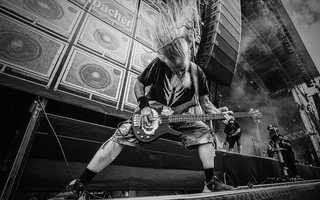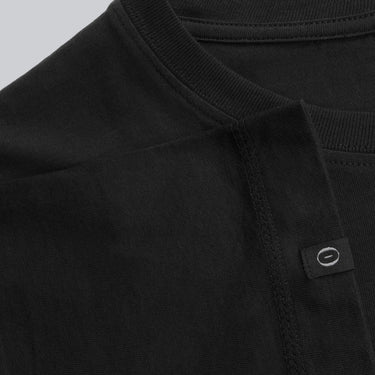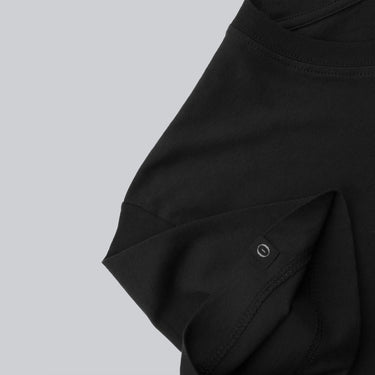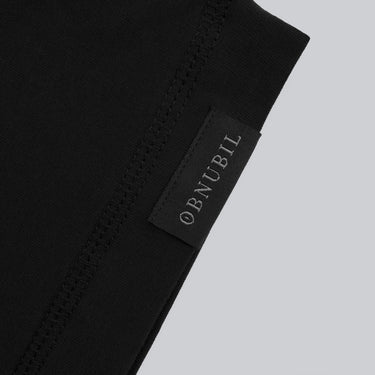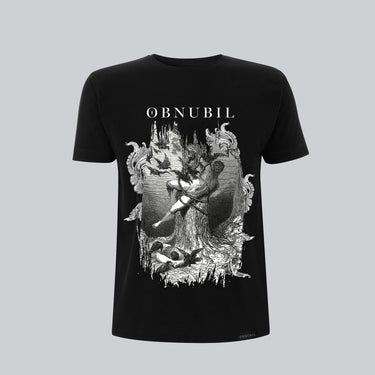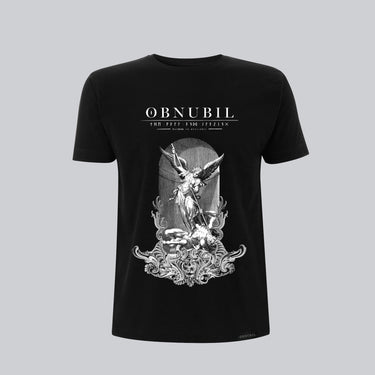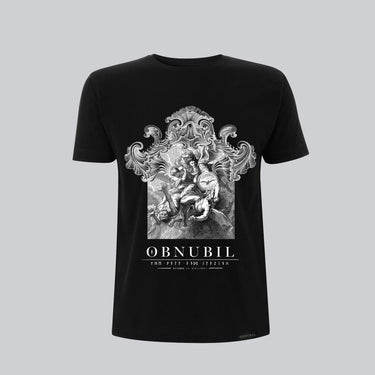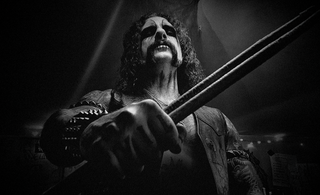
In this interview, the longest and most drum-focused interview I’ve conducted so far, I had the pleasure of diving into the world of Simon Schilling, drummer of Marduk, to explore the physical and mental demands of extreme metal drumming. With nearly 25 years behind the kit, Simon shares insights on technique, gear, and the discipline required to sustain his craft—where bodybuilding, precision, and creativity intersect. From the trance-like states of live performance to the quiet intensity of practice routines, Simon reveals how groove and nuance have become as vital to him as speed and power. What unfolds is a portrait of an artist who views drumming not just as rhythm, but as a balance of body, mind, and spirit.

INTERVIEW
OBNUBIL: Hi Simon! Before we dig into blast beats and brutal finesse — how’s life treating you these days, not just as a drummer but as a human navigating between noise and silence? Has anything lately — whether on stage, in the rehearsal room, or completely outside of music — unexpectedly grounded you, shifted your focus, or reminded you why you pour yourself into this art form in the first place?
Simon: First of all thank you for these in-depths questions and your interest in my stories and experiences. I am going through these questions with excitement and the certainty they’ll bring some new insights to daylight.
Life is great. We are playing lots of festival shows this year. That means being on the road for the weekends and being home during the week. The complete opposite to a normal work-week schedule. These hectic changes of playing shows one night and then being home alone the next night can really mess with you on a psychological level. One night thousands of people cheer on you and the next night you water your plants and wash the dishes haha. Your brain needs to process that. But then again, I am far away from complaining. I wouldn’t wanna change that.
I still go to the rehearsal room every day and practice. Not the same way I used to years ago, but that’s also a part of why I still enjoy it. Discovering new genres and new beats/fills keeps things exciting.
So, I think discovering new things keeps the focus alive and strong.
The saying "the more you know, the more you realize you don't know" is very true haha.
OBNUBIL: Simon, can you trace things back to that very first moment when music truly hit you in the guts - not just as sound, but as something physical, emotional, maybe even spiritual? Was it a drum fill that tore open your imagination, a record you looped obsessively, or a live show that completely rewired your sense of reality? When did it stop being "just music" and become something essential — something that defined your path not just as a drummer, but as a person shaped by rhythm, intensity, and creative obsession?
Simon: First encounters happened just by listening to the music my parents played. I didn’t grow up in an instrumental household. My parents just listened to radio but nothing specific at all. So the first tunes I remember were Toto for example. And Toto is still to this day very present in my life. Nostalgia is a force you can’t overcome. First bands, first movies, first loves... they are all burned to your memory.
But there was something about drums, the feeling and the rhythm of the hi hat especially, that caught my attention. I tried to imitate drum sounds in my room at that time. I found that plastic grocery bags had a bit of that sizzle sound of a hi hat. So, I used whatever worked as sticks and played on the surface of my mattress. Including plastic bags as hi hat sounds haha
I was always mesmerized by drums and the performance. It caught my eye, ear and interest and since then nothing ever has in the same intensity.
OBNUBIL: Let’s go straight into full-on drum nerd territory to kick this off. When you’re mid-set, locked into sustained blast beats at speeds well over 250 BPM — especially under blinding stage lights, heat, and the chaos of a black metal crowd — what’s happening inside your body at that moment? Do your limbs slip into autopilot mode, or are your hyper-conscious of every micro-movement in your wrists, fingers, ankles, and core? What’s going on with your breathing, your eyes, even your jaw tension? Is there a point where the physical act of drumming becomes so intense that it actually separates you from your body — like you're watching the machine from the inside?
Simon: I try to play it full autopilot. If I start to think about the motions I lose control. It might sound contrary but compare it with that experiment where someone asks you not to think about an elephant. The first thing you do is think about an elephant. Same goes here. If I think about that specific technique I am using at that very moment I am getting nervous if I still can hold it for another 20 seconds in that part and I am having a harder time keeping it up. If I don’t think about it, my muscle memory just takes over without any hesitation.
But your thoughts shouldn’t be too loose either. It’s happened a few times that my thoughts drifted away and I woke up again during a song asking myself how many bars are left haha.
But regarding breathing or any other specific technique. I try not to overthink things and try to act normal as I would do in my rehearsal room when I am on my own. And of course, enjoy the performance! This is a key part here. Have fun and not cramp up.
OBNUBIL: Many drummers describe their feet as being “disconnected” from their upper body during extreme double kick passages. How do you personally experience the coordination between your feet and hands when performing a complex blast beat pattern? Are they working in parallel like two teams, or is there a hierarchy in your internal clock — for instance, do you mentally "follow" your feet while your hands ride the chaos?
Simon: I am not really seeing them as two different teams or even opponents. Best case scenario they’re working together.
Focus wise I do prioritize my feet in fast parts since my hands are working more advanced in autopilot than my feet do. But I think that’s a common thing. It takes longer to develop a foot technique or highly delicate patterns with your feet than with your hands.
OBNUBIL: You've developed an extraordinary consistency at very high tempos, which implies not only muscular control but neurological conditioning. Can you walk us through how you’ve trained your nervous system to maintain clarity and micro-precision during extended blast passages? Are you conscious of specific neural pathways or mind-body rituals you've developed to maintain this level of tightness?
Simon: I started at a young age with endless stamina exercises. I was about 12 when I started with single stroke rolls exercises. And I did those exercises for years and years and pushed myself to crazy routines. 5 up to 10 minutes single stroke rolls straight without any breaks. Thats how you build stamina, hit by hit. And I think starting at this age stores information differently in your muscle mind connection than starting at let’s say 25 years of age.
OBNUBIL: When learning a new Marduk song or developing new material, do you visualize the structures in your head — such as through imagined maps, geometrical figures, color fields, or physical shapes? How much of your process involves a visual or sensory memory component that exists beyond the pure auditory or motor domain?
Simon: I have my own, very simplified way of sketching a song structure down on paper.
This is how my piece of paper would look like:
240bpm 4/4 - NAME OF THE SONG
-
-
-
- Riff 1 2x Guitar beginning with Cymbal/Kick Accents
- Riff 1 4x Blast Beat HI HAT
- Riff 2 4x 16 th Notes Double bass with Snare on 1 2 3 4 RIDE
-
-
In this example I sketch down a song in 4/4 at 240 bpm. The song starts with a guitar intro and some Cymbal hand stopper accents. These accents are mostly not notated since I learn these by memory.
Important for me is the number of bars/reps and which drumbeat comes next. All the fine details like fills or accents are already memorized by listening to the song. After the guitar-beginning the same riff continues for another 4 times with a blast beat, played on the HiHat. Then comes riff 2 with some 16 th notes double bass with the snare on all quarter notes. I write down the whole song like that.
99% of the time I won’t need that sheet live. While rehearsing I memorize the structure like learning a poem. So I have a two-way security system: I learn the song by playing along and have the muscle memory locked in plus I learn the structure from the sheet.
OBNUBIL: Before stepping on stage, what does your full pre-show physical preparation look like? Not just warm-ups on the pad — but everything: mental focusing, body priming, breath work, joint activation, even rituals you do backstage to get in the zone. Are there specific micro-exercises or drills you’ve found essential before exposing yourself to the muscular brutality of a Marduk set?
Simon: I try to stay calm and not think about the setlist or the songs. If I start to think about specific parts of the set, especially difficult parts, I am starting to get nervous and overthink.
Most of the time I use some pad-less exercises to warm up my wrists and fingers and do some air drumming.
Other times I try to find a pillow or part of a couch, sometimes also the drum riser works. And go through some rudiments, flams, singles and doubles for couple of minutes and that’s about it.
So for me, remaining calm is the most important mental focus.
OBNUBIL: Have you ever entered what could be called a trance state while drumming — a condition where time collapses, body awareness blurs, and all that exists is the pulse and the violence of the moment? If so, what triggers that for you? Is it repetition, volume, crowd energy — or something darker or more spiritual?
Simon: I can lose myself when I have a good sound on stage. When I can feel the kicks vibrating, the tone of the toms echoing back and forth and the depths of the snare hammering. On the other hand, you also need the feedback from the crowd to really enjoy a show. If there is no energy reflecting, you lose the spirit.
But if you see the fans enjoying themselves and letting loose, it drives you to even greater ecstasy.
OBNUBIL: Let’s break it down into fine grains of obsession: What is your current pedal setup in precise technical terms — spring tension (in grams or turns), beater angle, footboard height, cam preference — and how did you arrive at these particular settings? What were the trial-and-error moments that shaped this configuration into something that now feels like a second spine?
Simon: The settings are built around my current technique I am using. For heel toe I really like to have my pedals bouncy and tight. That means the VDL shift at my axis pedals are 85% down. The spring tension is around 80% and the beater distance to the head is kinda short, at around 30 degrees.
The settings differ to my previous technique and set up. When I played single strokes and used the swivel technique, I needed a way further beater distance to the drum head than I am having now. Also the VDL was more centered than it is now. That gave the beater a greater swing. With heel toe you don’t really need more swing, it is more irritating for the second hit if you have a further way.
But certain techniques need different approaches and settings. You will only find out about that yourself with the learning-by-doing approach. Its a hard lesson we all must go through haha.
I remember trying out different pedal settings from my favorite drummers over the years and I couldn’t make them work for me. We all have different body attributes which make us different, and we need to adjust things on a personal level.
OBNUBIL: If someone were to replace your snare drum with a duplicate that was 99% identical but not the real one, would you notice immediately? What are the micro-characteristics — tension response, rim attack, overtone curve — that make a snare uniquely “yours” in a way that can't be replicated, even by gear that looks the same?
Simon: No, I would not notice that small of a change.
I never bring my own snare to gigs. I always play the backline kit including backline snares. That means I am hitting on a lot of different snares and drumkits all the time. And they are all equipped with different heads, different snare wires and they are also made from different materials and sizes. They all sound and feel completely different.
At home I change my snares all the time as well. I have quite a collection and I like to go through them and not just let them collect dust. I use all kinds of different heads to get used to the different feeling.
But my preference is a medium-tight batter head, very cranked bottom head, tight wires and some muffling on the batter side. The preferred head is probably a Remo coated black dot or clear pin stripe for that fat 80s sound.
OBNUBIL: If your drum kit caught fire and you could save only one piece of gear before the flames consumed it all, which item would you rescue and why? What’s the one component — be it a battered pedal, a specific snare, a cracked crash, or even a stool — that carries an almost talismanic weight for you?
Simon: I would go for my axis signature pedals. They are the only piece of gear I always bring. Sticks do break and get replaced and thrown into the crowd, cymbals are rented from time to time or get destroyed and changed but pedals always stay the same.
OBNUBIL: Is your relationship to drumming primarily spiritual, physical, intellectual — or something more complex than all three combined? When you perform songs like “Panzer Division Marduk” night after night, does it ever feel like a ritual exorcism? What does your body and mind go through emotionally during these live experiences, especially in the faster or more relentless sections?
Simon: It definitely is a combination of all three. Drumming calms me and excites me at same time. It does challenge me and also provides serenity. If you break it down, especially if you hit plateus, it is a love and hate relationship.
Drumming has been the biggest part of my life for almost 25 years. A lot of things about it give me a feeling of nostalgia. And as we all know, nostalgia is such a powerful feeling. Songs from the Panzer Divison Album give me exactly that feeling. "Fistfucking Gods Planet" was the very first Marduk Song I ever heard on a sampler CD back then. Every time we play that song live I connect with my younger self and this gives me a boost on stage! That happens with a lot of songs live.
OBNUBIL: Many black metal drummers either chase machine-like perfection or embrace a raw, chaotic looseness. Where do you place yourself on that spectrum — and do you believe black metal requires a particular balance between technical rigor and what one might call ‘intentional imperfection’?
Simon: It has shifted over the years. When I started to become an extreme metal drummer at the age of 12, I was really into machine gun like blast beats, straight and without any breaks in it. That’s also where my stamina comes from, all these exercises at a young age. Nowadays I want to add groove into these relentless blast beats. Its not an easy task since a blast beat is a single stroke roll with no intentioned dynamics. But I try to play thinner ride cymbals for example and accent hits with crashing the ride or I am adding lots of bell accents. Same goes with the Hi hat. Adding different layers of sound by opening up the Hi hat.
For me music is all about groove and if it moves you. If it does, technique is not the most important thing.
OBNUBIL: Black metal often glorifies the “inhuman” — and some drummers aspire to play as if they were machines. Do you believe the human element (like slight variations in timing or emotional micro-choices) is essential to true black metal drumming? Or is transcendence in this style best achieved by abandoning humanity altogether in pursuit of unrelenting discipline?
Simon: You can’t take these imperfections away since we are still human. And thats what makes it to music in my opinion. I lost myself a bit in that thought when I was younger. I wanted to eliminate all these human touches. But this was plain and simple naivety. I saw videos or heard records which were obviously quantized, and I wanted to sound exactly like them. But you just simply can’t. Since I realized that and got rid of the pressure I put myself under, I can enjoy the actual part of playing drums way more.
In the end it always depends on the music. If you listen to old black metal records and imagine them with perfect quantized drums, they would not unleash the same spirit as they do.
OBNUBIL: If someone transcribed one of your drum performances into pure language — let’s say a novel or a philosophical text — what do you think it would be about? What story, conflict, or theme do you think your drumming communicates, beyond tempo or technique?
Simon: If you break down my drumming into pure language it means something very chaotic yet personal. I always give my soul and emotions into every performance. On the other hand, you must learn that a song is always superior to your drumming ideas. Your ego has to take a step back to let the song breath, yet we drummers want to create these crazy parts. That is often contrary. During a recording process we need to fight battles in our mind either if we want to fight for that specific fill to stay on the record or if we put our needs behind the song's needs.
The older I get the more I realize that.
You can compare it to a tightrope act.
I guess in the end I want to show myself on stage as the person I am at that very moment in life. Adding the quintessence of my current state of mind.


OBNUBIL: Which specific exercises or drills do you consider absolutely essential to maintaining your level of playing — especially those that may not be obvious to most extreme metal drummers? Are there technical practices from outside metal that have profoundly influenced your speed, control, or stamina?
Simon: I am working a lot on rudimental exercises. Flams, paradiddles, groups of threes, fours, fives etc. Those are perfect for coordination, muscle mind connection and creativity especially when you cooperate your feet into the exercises. I am not working on speed or stamina so much anymore. Playing constant shows and tours is working on my stamina by itself.
OBNUBIL: Have you explored any form of physical optimization — such as endurance training, yoga, mobility work, fasting, or breathing techniques — to enhance your drumming capacity? What do you consider to be the most underrated aspect of physical preparation for extreme music?
Simon: I do bodybuilding. But not primarily for the matter of speed or stamina at the drumkit. I started years ago to balance my drumming routine. Sitting for hours on your drum stool and doing the same motions, by leaning forward and having your shoulders upfront all the time, can damage your posture. So I started to work out as a preventive act.
But it’s not only the drumming what needs a healthy balance, it is also the hours sitting in an airplane, at an airport, sleeping in a tourbus etc. This all requires a healthy and strong body and mind! And working on your body does exactly that!
Plus, I can feel a benefit for my playing as well. It is a win-win situation!
OBNUBIL: What is your personal definition of growth or improvement in your drumming at this stage in your career? Is it about pushing the BPM boundary further, refining subtle details, deepening emotional expressiveness — or something else entirely?
Simon: At this stage of my career it’s all about groove, exploring different genres, opening up my mind for new vocabulary.
I worked for years on speed and stamina and I reached a level where I am happy with and can concentrate on other things which I never could find the interest and time in when I was younger.
OBNUBIL: Do you track your practice in any detailed way — such as using timers, BPM charts, video review, or journaling? How do you keep yourself accountable and avoid slipping into autopilot when rehearsing?
Simon: I was always intensely focused and involved so I remembered my current progress and didn’t have to write it down.
Nowadays I practice a lot with books. Means I am going step by step through it, which means you don’t really need to write your progress down. It also happens that I see a great video online which I then send myself and rewatch it and try to play it.
It also helps to put exercises aside you can’t handle yet. You keep going with the next chapters and after a few weeks you revisit it and out of a sudden it works.
OBNUBIL: Tell us about a time you hit a significant wall in your development — either technically or psychologically — and walk us through how you dismantled that block. What tools, mindsets, or epiphanies helped you evolve beyond it?
Simon: I constantly hit walls the second I try new things. But that’s part of growing and becoming a better musician and human being. We must learn that growth only comes with patience and steady repeating. If it was easy, the reward afterwards wouldn’t mean anything. The feeling of finally nailing a fill or groove or a certain tempo is unmatchable. It’s not a big secret at all - it's just the power of a strong mind and keeping the focus.
OBNUBIL: What's the most rhythmically unexpected or compositionally subversive thing you've ever done on a Marduk recording — something that might even surprise the band’s fans or go unnoticed unless they isolated the drum track?
Simon: The last Marduk album has a very raw sound and so do the drums. I added some ghost notes here and there which I am sure got unnoticed.
Rhythmically the Blast sections in Year of the Maggots might stand out.
In addition, I decided to use a more open Ride Cymbal for the record to be able to crash it and add some more depth to the sound instead of a regular thick metal ride.
OBNUBIL: Silence is often overlooked in extreme metal. Do you see silence or negative space as a tool in your compositions — and how do you wield it in a genre so defined by saturation and speed?
Simon: I am honestly still at a learning process here. As you mention in your question, extreme metal is very defined by speed. It’s easy to lose yourself in it. Always chasing the speed train. But the more experience I get the more I see the importance of a deep breath in the music. Differences make the impact shine brighter. If you calm down for a second and get back to hyperspeed the effect is way bigger.
OBNUBIL: Simon, you’re playing lives right at the edge between surgical precision and total sonic warfare — and you seem to thrive in that tension, shifting effortlessly depending on which band or project you’re behind the kit for. Looking ahead, what’s stirring in your musical world right now? Are there upcoming albums, tours, collaborations, or perhaps even new stylistic territories you’re venturing into that have you especially charged up? What should we be preparing for — or maybe bracing ourselves for — from you in the coming months across your different incarnations behind the drums?
Simon: Even after 24 years of drumming I am still eager to play every day. A different approach to 10 years ago, for example, but this is what keeps it interesting. As we grow as humans we also grow with our passions and interests. There is also a lot of enthusiasm for songwriting growing inside of me. Giving birth to the ideas always floating around in my head is a very fulfilling experience, a new approach of creativity.
Touring-wise the autumn starts with another drum camp/festival in Vienna followed by a Latin American tour and an Asian tour right after. Lots of travelling ahead!
OBNUBIL: It’s been a blast diving deep into your world of rhythm, fire, and precision. Thanks for taking the time to share so much about you. Before we wrap this up, is there anything you’d like to leave behind for those who’ve followed your journey — whether they’re die-hard fans, fellow drummers, or just curious souls drawn to the chaos? Any final words of gratitude, reflection, or raw philosophy you’d like to throw into the void before we close the curtain on this chapter?
Simon: I’d like to give every drummer the advice to enjoy what they do and don’t let social media fool you! There are too many charlatans out there trying to impress you with the wrong intentions.
Stay focused and have fun, then there will be no limits for you!
Also thank you for reading till the end and see you on the road!!
Interview done September 2025. Cover photo by Unknown, Artur Tarczewski & Rin Fotografie.


